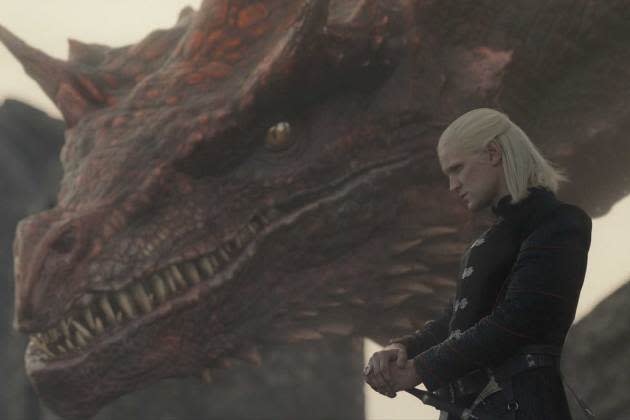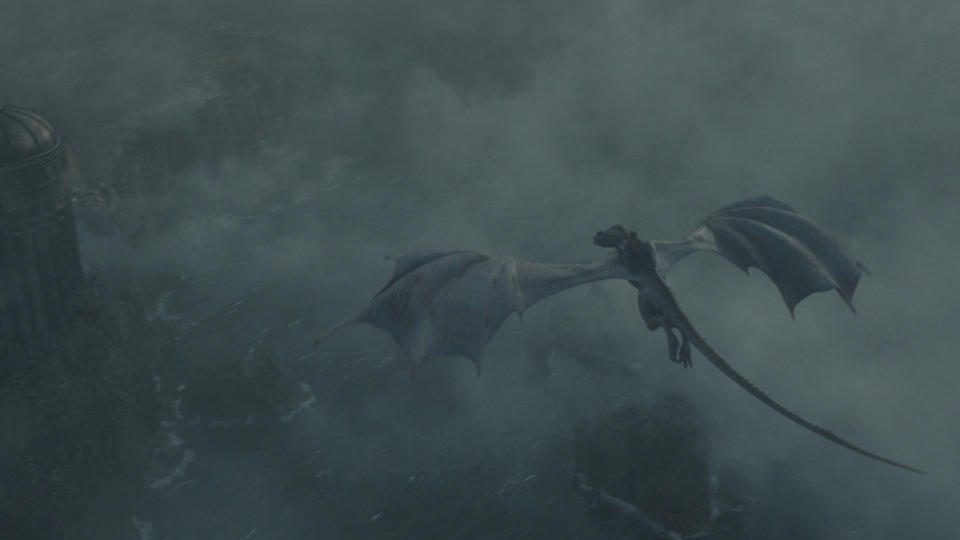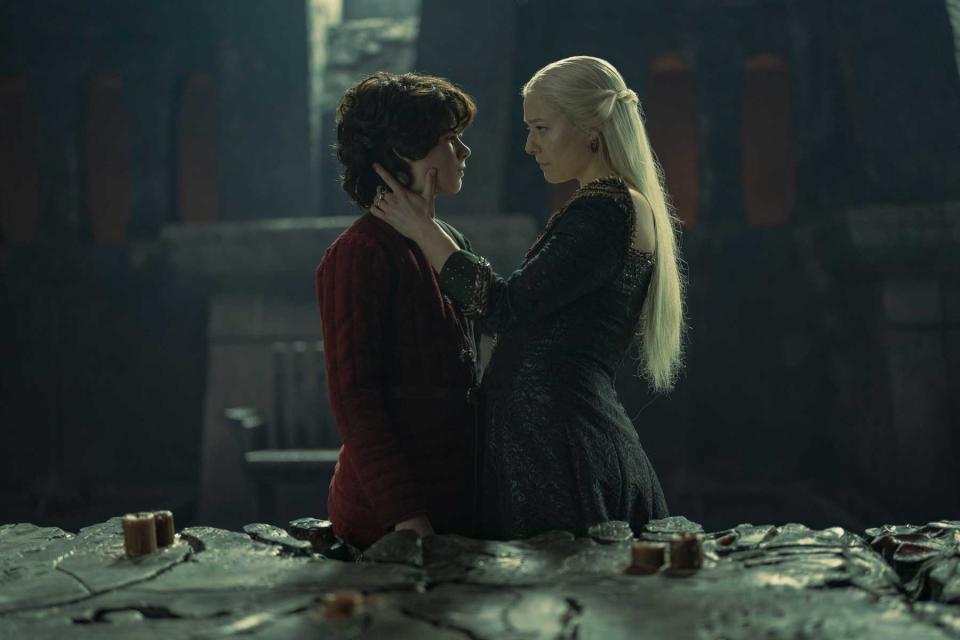‘House of the Dragon’ May Be a Prequel to the Most Popular TV Show Ever. It Still Came Up Short
- Oops!Something went wrong.Please try again later.
- Oops!Something went wrong.Please try again later.

This post contains spoilers for the first season of House of the Dragon, which is now streaming in its entirety on HBO Max.
“The Black Queen” was the season finale of House of the Dragon Season One, and its climax appropriately summed up nearly everything about the show, good and bad.
More from Rolling Stone
'House of the Dragon' Season Finale Recap: All Hail the Black Queen
Bartenders Are Cool If You're Horny for a Negroni ... Sbagliato ... With Prosecco in It
As the cocky, sadistic Prince Aemond (Ewan Mitchell) chased his anxious nephew Prince Luke (Elliot Grihault) through a stormy sky, pitting his massive dragon against Luke’s comparatively tiny one, it was impossible to not be impressed by the visual splendor, the palpable tension, and the overall technical mastery of director Greg Yaitanes and the series’ VFX team. Luke dies after both princes lose control of their respective dragons. This not only provides one final harrowing death for a very violent season, but stands as a harbinger for the eventual doom of House Targaryen and its dependence on these fire-breathing beasts. Luke’s death was followed by one last glimpse of Emma D’Arcy’s unwaveringly fierce performance as Queen Rhaenyra, whose hope for a relatively non-violent end to the coup in King’s Landing died along with her son.

Yet despite that exciting duel above Storm’s End, despite that great final shot of D’Arcy staring right down the barrel of the camera — implicating the show’s bloodthirsty audience in Luke’s death every bit as much as she was plotting vengeance on Aemond and his mother Alicent (Olivia Cooke) — that action sequence rang hollow. Because ultimately, who was the boy formally named Lucerys Velaryon, other than a pawn in this ancient game of thrones created on the page by George R.R. Martin(*)?
(*) Though if you have to be a pawn, at least it’s in a game where one side has an impressive, fire-lit stone map on which to plot strategy.
The finale was written by Ryan Condal, who worked with Martin to adapt Fire and Blood, a fictional history of House Targaryen, for television, and who operated as the HotD showrunner. Condal treated this entire season as a prologue to the story he and everyone else seems more excited about: the war between the Blacks loyal to Rhaenyra and the Greens loyal to Alicent and the usurper king Aegon (Tom Glynn-Carney). This is part of a larger trend in television, where many serialized dramas structure their first seasons as a premise pilot for the show the creators really want to make. When you are a prequel to one of the most popular TV series ever made, there is more security in doing this than if you are a Netflix show without a brand name or big stars.
Still, the approach Condal took was unusual. These 10 episodes spanned roughly 20 years in the lives of Rhaenyra, Alicent, Rhaenyra’s uncle-turned-husband Prince Daemon (Matt Smith), Alicent’s scheming father Otto Hightower (Rhys Ifans), and everyone else. So the show began with the future rival queens as teenage pals, played by Milly Alcock and Emily Carey. After five episodes, the narrative leapt forward a decade, and a couple of episode after that, we skipped ahead six more years.
Though the two central characters came through just fine with the actor switch (Alicent even benefited from Cooke’s arrival), these time jumps became dizzying and narratively harmful. Rhaenyra and Alicent’s children were becoming huge parts of the story, but the chronological leapfrogging made it impossible to get a handle on all but the most superficial qualities of each, if that. (Luke at least had his self-doubt as a notable characteristic, whereas his older brother Jace, played by Harry Collett, is… there.) Just when the younger versions of them were starting to come into focus, they aged significantly and were now being played by new performers, once again eluding our grasp.
Even worse, the structure made a complete hash out of the arcs of several key characters, most notably Daemon. In the Milly Alcock episodes, he is a petulant sociopath, convinced that he, and not his weak older brother Viserys (Paddy Considine), deserves to rule Westeros. He sows dissent in King’s Landing, coldly murders his first wife so he can inherit her lands, and is otherwise treated as the villain of the story. Though smitten with his niece — and seemingly only able to perform sexually with her — he winds up marrying cousin Laena (Nanna Blondell). After the 10-year time jump, he is presented as a devoted husband and father, albeit one who is pouting in self-imposed exile in Essos. When Laena commits suicide-by-dragon following the stillbirth of their next child, Daemon then marries Rhaenyra. This is a political move, and a somewhat shady one — it includes the two of them helping to fake the murder of her closeted first husband so he can live his truth far away from anyone who knows him. But again, Daemon is positioned as someone we are not meant to view as a monster, in spite of everything we witnessed in the season’s first half.
By the time early in “The Black Prince” where he is plotting war against the Greens while Rhaenyra literally yanks their stillborn child out of her womb(*), it seems impossible to parse his motivations, nor his feelings about his wife, his stepsons, his biological children, or anyone else. In a later scene, Rhaenyra brings up the “Song of Ice and Fire” prophecy — which will come true close to 200 years later, as dramatized on Game of Thrones — and Daemon, who has been kept out of the big Targaryen family secret, begins to choke her. Does he resent her for being in the loop when he was not? Is he angry that she is using this as an excuse to not go to war with the Hightowers? Is he incapable of loving anyone or anything but himself and his lust for power? Who the hell knows?
(*) Have someone love you the way HotD loves graphic and painful childbirth scenes that often end in the death of the mother or child.
Condal seemed willing to make these big time jumps to make sure the season covered all of the important bits. Clearly to him and the rest of the creative team, those important bits involved major historical signposts along the path to war, and/or dragon sequences. But in sacrificing character development — see also: the show skipping over Rhaenyra’s reaction to the news that her father would be marrying her best friend — HotD became content to skim along the surface of the material, rarely getting deep enough for any of it to matter. Not coincidentally, perhaps the season’s most effective episode was its eighth, about the troubled final days of King Viserys, one of the few characters the show kept a strong grip on from beginning to end(*).
(*) He was also the only character on the show who either wasn’t replaced by another actor or else failed to visibly age during the time jumps. Daemon and Otto look exactly the same as they did at the beginning of the timeline, where Viserys was a barely-animated corpse by his farewell episode.

And some of the dragon scenes existed solely for the spectacle, rather than to confirm or enhance our understanding of the people involved. When Viserys’ cousin Rhaenys (Eve Best) interrupts Aegon’s bogus coronation on the back of her dragon, she has a perfect opportunity to incinerate him, Alicent, Otto, and all these other traitors to the realm, and to end the war that’s coming before it starts. Instead, she lets the dragon growl at the insurrectionists before flying off. In the finale, she claims “That war is not mine to begin,” but soon after, she tells her husband Corlys (Steve Toussaint) about the importance of siding with Rhaenyra and defeating the Hightowers to ensure their family is safe. Her interruption of the coronation seemed to happen only because one of the producers said, “This episode could use some dragons,” without thinking through what that would mean for Rhaenys or anyone else.
The inciting incidents of Game of Thrones are Ned Stark being asked to be the Hand of the King for his old friend Robert Baratheon, and Jaime Lannister shoving Bran Stark out a window. An argument could be made that it should have instead started with Robert leading a rebellion against the rule of the mad king Aerys Targaryen, since so many crucial components of the show happened back then. But both Martin (in his novel) and David Benioff and D.B. Weiss (on the show) understood that they couldn’t get mired in backstory, and that it was important to begin with the story they planned to tell. Many of those prior events were discussed later, like Jaime’s conflicted feelings about murdering Aerys in order to save the kingdom, and in ways that enriched the characters and the series as a whole. “Show, don’t tell” is conventional storytelling wisdom, but sometimes telling can be better, especially when the showing requires so much temporal chicanery.
With Luke’s death and Rhaenyra’s new desire for vengeance, we appear to be at the point where House of the Dragon can finally become the show it always wanted to be. Perhaps now that we will be living in one time period for a while, Condal and company can do better by the people in this story, rather than short-changing them in favor of living up to the title of Martin’s history book. But this season’s priorities don’t feel promising in that regard. It took years before Game of Thrones had both the money and the technical expertise to pull off epic battle sequences, which forced Benioff and Weiss to dwell more on getting to know Ned, Arya, Cersei, Brienne, and friends. That built a sturdy framework which could eventually support the battles and zombie attacks as something richer than mere showiness. Condal has all the money in the world, so he is racing to get to the flashier stuff without fretting nearly as much on the foundation on which this House rests. Until the people matter as much as the dragons, the prequel will have a hard time living up to the show that inspired it.
Best of Rolling Stone

